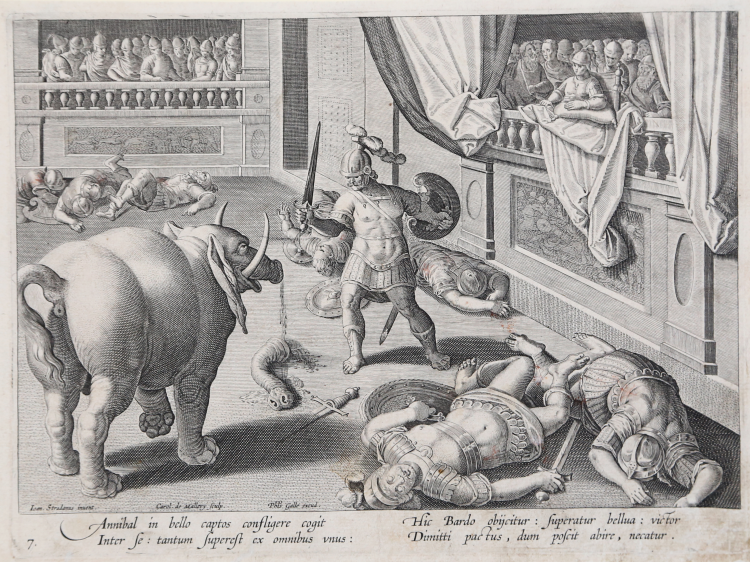




| Reference: | S12482 |
| Author | Carel van Mallery |
| Year: | 1596 ca. |
| Measures: | 260 x 200 mm |



| Reference: | S12482 |
| Author | Carel van Mallery |
| Year: | 1596 ca. |
| Measures: | 260 x 200 mm |
A Roman Soldier Fighting one of Hannibal's Elephants: centre, a Roman soldier, armed with a sword and shield, cuts off the trunk of an elephant, captured during a battle with Hannibal; the rest of the arena is littered with the bodies of men previously overcome by the elephant, to far left and right, spectators watch the contest from a balcony.
Lettered within image: 'Ioan. Stradanus invent. / Carol de Mallery sculp. / Phls Galle excud.' Plate numbered 7 in margin at left. Lettered below the image: Latin text arranged in two columns, 'Annibal in bello...abire, necatur.
Engraving, circa 1596.
From the "Venationes Ferarum, Avium, Piscium", after Jan van der Straet called Stradano or Stradanus, published by Philip Galle.
Once back in Antwerp, after a long trip to Italy, Stradano met Philip Galle, former pupil of Hieronumus Cock, who had recentely devouted himself to the art of printing. They planned together the realization of hunting subjects, inspired by the tapestry of the Villa in Poggio a Caiano. At the beginning, Galle realized a series of engravings without numbers, to which a second edition followed, with title page and 44 numbered plates. The sudden fame of his work convinced the printer to go on with his cooperation with Stradano, who realized new drawings with uncommon and exotic hunting subjects.
The new series was published first separately, then together with the first edition, forming a wide series of 104 plates, named Venationes Ferarum, Avium, Piscium, Pugnae. This work can be dated between 1578 (on the front page) and 1596. As for the tapestry of the Villa in Poggio a Caiano, the work is divided in three wide categories: terrestrial, air and water animals. At the beginning the hunting scenes have been engraved by Philip Galle himself, who then hired other members of his family and other assistants, among which Adriaen and Jan Collaert, Theodor and Cornelis Galle and Carolus de Mallery.
Magnificent work, printed on contemporary laid paper, trimmed to the platemark, in good condition.
Bibliografia
New Hollstein (Dutch & Flemish) / The New Hollstein: Dutch and Flemish etchings, engravings and woodcuts 1450-1700 (470.I); Baroni Vannucci 1997 / Jan van der Straet, detto Giovanni Stradano, flandrus pictor et inventor (693.7).
Carel van Mallery (Anversa 1571 - 1635 circa)
|
Karel van Mallery (1571–1635?) was a Flemish engraver who mainly worked on religious subjects and portraits and was also a reproductive engraver. He worked in Antwerp and Paris. Karel van Mallery was born in Antwerp. He was a pupil of Philips Galle. He was registered as a pupil in the Antwerp Guild of Saint Luke in 1585. He travelled to Rome in the years 1595-1597 and when he returned to Antwerp he became a master in the Guild in 1597. He married Catharina Galle, the daughter of his teacher on 10 January 1598. They named their son Philips. From 1601 he worked in Antwerp and in Paris for a period of about five years. In 1620-1621 he became deacon of the Antwerp Guild and in 1626 he lived in the Keyserstraet. He was the teacher of his son Philips van Mallery and the engraver Michel Natalis.
|
Carel van Mallery (Anversa 1571 - 1635 circa)
|
Karel van Mallery (1571–1635?) was a Flemish engraver who mainly worked on religious subjects and portraits and was also a reproductive engraver. He worked in Antwerp and Paris. Karel van Mallery was born in Antwerp. He was a pupil of Philips Galle. He was registered as a pupil in the Antwerp Guild of Saint Luke in 1585. He travelled to Rome in the years 1595-1597 and when he returned to Antwerp he became a master in the Guild in 1597. He married Catharina Galle, the daughter of his teacher on 10 January 1598. They named their son Philips. From 1601 he worked in Antwerp and in Paris for a period of about five years. In 1620-1621 he became deacon of the Antwerp Guild and in 1626 he lived in the Keyserstraet. He was the teacher of his son Philips van Mallery and the engraver Michel Natalis.
|